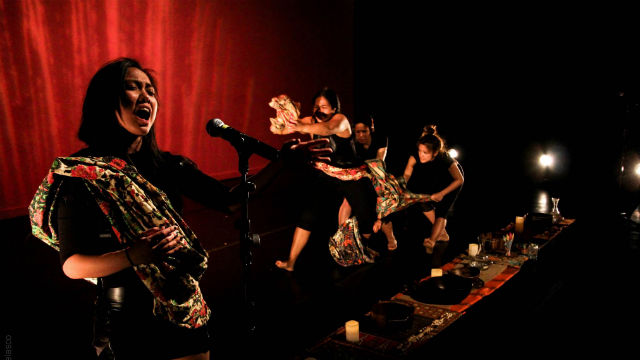SUMMARY
This is AI generated summarization, which may have errors. For context, always refer to the full article.
 NEW YORK CITY – I made my way up several flights of stairs, where I was greeted and asked to choose a small stone from a bowl before entering the performance space. Each audience member did the same, and wrote a word or their name on their stones – I elected to scribble down the word “love” in Arabic. We placed them on the altar, located on stage right, and took our seats.
NEW YORK CITY – I made my way up several flights of stairs, where I was greeted and asked to choose a small stone from a bowl before entering the performance space. Each audience member did the same, and wrote a word or their name on their stones – I elected to scribble down the word “love” in Arabic. We placed them on the altar, located on stage right, and took our seats.
Jana Lynne “JL” Umipig, the director, creator and producer of The Journey of a Brown Girl, explained to the audience that the stones were meant to absorb the positive energy from the show, and that we were free to retrieve our stones at the conclusion of the night’s event.
The energy that flowed through WOW Café Theater that evening was beyond positive. It was also a mix of wonder, anger and passion; wonder – for many of the issues that the piece as a whole raised, all of which sparked curiosity and reflection among the audience; anger – for the many misfortunes and atrocities that fellow Filipina women have had to endure throughout the course of history; and passion – for the intense level of emotion that each the five characters evoked during the performance.

The Journey of a Brown Girl did not follow a particular storyline. Instead, it was a collective; it was an exploration of Filipina issues and experiences through several lenses.
Following the opening ritual, the five women gathered for “Ina sa Anak na Babae (Mother to Daughters).” Light, played by Precious Sipin, was the mother figure of the four other elements. Her four daughters were Wind (Renee Rises), Water (Leslie Hubilla), Fire (Vanessa Ramalho) and Earth (Karen Pangantihon). Each of the women in the show used a malong throughout the performance. The malong is defined by Umipig as “a life cloth.” Umipig describes the malongs as garments that:
“… become an extension of the spirits of the woman and are used throughout to help them transform into characters and to give to the stories of all the sisters, mothers, wom*n, and girls whose voices fill the piece… From cradle to grave, this is how the malong serves the Maranao. The malong is a tube-like, unisex garment that also symbolizes the Maranao’s artform and culture.”
In a commentary on the Catholic Church, poignantly referred to as “Sit, Stand, Kneel,” Light knelt on stage right, deep in prayer. As they sat, stood, and knelt non-stop, the four daughters began to itch with frustration. They recognized that they had been conditioned to abide by the expectations of the church, regardless of their understanding of faith and spirituality.
“I know Him, but I know the hymn by heart,” one of the daughters stated with discontent.
The wide disconnect between the church and women’s issues as a whole is still evident today. Change, though slow, requires arduous effort. Just this past week in the Philippines, the Supreme Court passed the RH bill, which previously faced much opposition by the Roman Catholic Church.
“The Reproductive Health Law is a historic step forward for all women in the Philippines, empowering them to make their own decisions about their health and families and participate more fully and equally in their society,” states Nancy Northup, president of the Center for Reproductive Rights. Still the church continues to clash with women’s rights, especially in the Philippines and among Catholic women of the Filipino diaspora.
The performance also presented the modern Filipina woman as an individual that is often overlooked in society. The performers took turns telling the accounts of OFWs who have become domestic workers after leaving the Philippines. These portraits explained the trials that domestic workers are subjected to, including receiving little or no pay, enduring physical and sexual abuse, and experiencing the inability to break contract and leave their employer. The piece went on to portray trafficked Filipinas who have been deceived by recruitment agencies or individuals and forced into sex slavery abroad. The performers took on a different persona, reflective of the women whose stories they were telling. They took turns recounting several interviews and recollections over candlelight. Hearing these chilling tales brought tears to many in the audience, myself included.
The latter half of the piece explored the perception of beauty among Filipina women. Light encouraged her four daughters to make their skin white by smearing thick layers of lightening cream upon their faces. Watching the women cover up their brown skin was comical at first; they appeared to buy into the acceptable perceptions of beauty (according to their mother and society). Eventually, each of the daughters realized that they were hiding their true selves, and began to wash away their masks.
All I could think of during the performance was how much I understood each of the daughters – and even the mother. The performers portrayed Filipina women as victims of circumstance. Those circumstances ranged from religious faith and spirituality to colonialism and globalization. However, each of the women also portrayed strength, perseverance and resilience.
After the show, I approached Umipig, and thanked her for such a moving experience.
“It was like you were telling my story,” I admitted to Umipig.
“That’s because it is your story,” she assured me – Rappler.com
Ryann Tanap is Pilipino American Unity For Progress’ (UniPro) blog editor. We are republishing this blog with her permission.
Read previous stories
Add a comment
How does this make you feel?





There are no comments yet. Add your comment to start the conversation.